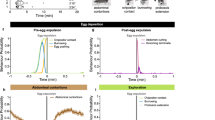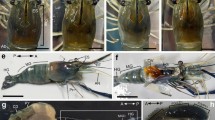Summary
The spontaneous discharge of the neurosecretory bag cells causes ovulation in the marine gastropod,Aplysia brasiliana, but the overt head movements that subsequently deposit the eggs on the substrate are initiated before the bag cells fire (see accompanying paper). Injection of homogenized abdominal ganglia (HAG) containing bag cells into intact animals triggers (1) release of eggs from the ovotestis, (2) similar head movements associated with egg deposition and (3) a sustained period of inhibited feeding. We now report that the full expression of the overt behavioral effects of HAG injections are influenced by egg movement through the reproductive tract. When egg movement is blocked at the small hermaphroditic duct (SHD) near the ovotestis, HAG injected animals show significantly decreased head oscillations compared to mock operated controls. Furthermore, SDH ligated animals do not stop responding to food after HAG injections, unlike mock operated animals that show complete inhibition of feeding. Thus movement of eggs through the reproductive tract beyond the SHD is required for normal head movements and feeding inhibition. Artificial “egg” movement through a cannula in the reproductive tract indicates that neither HAG injection nor movement of artificial “eggs” alone triggers head movements effectively. However, the combination of HAG and artificial “eggs” triggers behaviors quantitatively more similar to those with normal egg movement. Finally, denervation of the reproductive tract does not prevent the normal occurrence of head movements following HAG injection when eggs are allowed to move normally. These results suggest the hypothesis that the release of bag cell hormones and the subsequent movement of eggs normally maintain the previously initiated head movements so that egg laying behaviors stop when all of the eggs are deposited.
Similar content being viewed by others
Abbreviations
- CGG :
-
common genital groove
- LHD :
-
large hermaphroditic duct
- SHD :
-
small hermaphroditic duct
- HAG :
-
homogenized abdominal ganglia containing bag cells
References
Arch S, Smock T (1977) Egg-laying behavior inAplysia californica. Behav Biol 19:45–54
Barrington EJW (1978) Evolutionary aspects of hormonal structure and function. In: Gaillard PJ, Boer HH (eds) Comparative endocrinology. Elsevier/North-Holland, Amsterdam, pp 381–396
Cobbs JS, Pinsker HM (1979) Hormonal modulation of egg-laying behaviors inAplysia brasiliana. Soc Neurosci Abstr 5:243
Cobbs JS, Pinsker HM (1982) Role of bag cells in egg deposition ofAplysia brasiliana. I. Comparison of normal and elicited behaviors. J Comp Physiol 147:523–535
Coggeshall RE (1971) A possible sensory-motor neuron inAplysia californica. Tissue Cell 3:637–648
Coggeshall RE (1972) The structure of the accessory genital mass inAplysia californica. Tissue Cell 4:105–127
Davis WJ, Mpitsos GJ, Pinneo JM (1974) The behavioral hierarchy of the molluscPleurobranchaea. II. Hormonal suppression of feeding associated with egg-laying. J Comp Physiol 50:225–243
Kandel ER (1979) Behavioral biology ofAplysia. Freeman, San Francisco, California, pp 1–463
Kupfermann I (1974a) Feeding inAplysia: a simple system for the study of motivation. Behav Biol 10:1–16
Kupfermann I (1974b) Dissociation of appetitive and consummatory phases of feeding behavior inAplysia: a lesion study. Behav Biol 10:89–97
Pinsker HM (1980) Neuroethological analysis of information processing during behavior. In: Pinsker HM, Willis WD Jr (eds) Information processing in the nervous system. Raven Press, New York, pp 285–312
Pinsker HM, Dudek FE (1977) Spontaneous bag cell activity and egg-laying in freely-behavingAplysia. Science 197:490–493
Robinson DA (1981) The use of control systems analysis in the neurophysiology of eye movements. Annu Rev Neurosci 4:463–503
Scharrer B (1970) General principles of neuroendocrine communication. In: Schmitt FO (ed) The neurosciences, Second study program. Rockefeller University Press, New York, pp 519–529
Slater PJB (1978) Sex hormones and behaviour. University Park Press, Baltimore, Maryland, pp 1–58
Stuart DK, Strumwasser F (1980) Neuronal sites of action of a neurosecretory peptide, egg-laying hormone, inAplysia californica. J Neurophysiol 43:499–519
Thompson TE, Bebbington A (1969) Structure and function of the reproductive organs of three species ofAplysia (Gastropoda: Opisthobranchia). Malacologia 7:347–380
Turgeon JL (1980) Neural control of ovulation. Physiologist 23:56–62
Author information
Authors and Affiliations
Rights and permissions
About this article
Cite this article
Cobbs, J.S., Pinsker, H.M. Role of bag cells in egg deposition ofAplysia brasiliana . J. Comp. Physiol. 147, 537–546 (1982). https://doi.org/10.1007/BF00612019
Accepted:
Issue Date:
DOI: https://doi.org/10.1007/BF00612019




